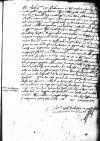List #1792
Ioannes DANTISCUS do Fabian WOJANOWSKI (DAMERAU)Löbau (Lubawa), 1537-11-16
Rękopiśmienne podstawy źródłowe:
Pomocnicze podstawy źródłowe:
Publikacje:
| ||||||||||||
Tekst + aparat krytyczny + komentarz Zwykły tekst Tekst + komentarz Tekst + aparat krytyczny
Nobili Domino
Mi carissime Domine Fabiane.
Si bene vales, ubicumque sis, ms 2 nihil,
ms 1 [nihil] paper damaged⌈nihilms 2 nihil,
ms 1 [nihil] paper damaged⌉ mihi potest esse gratius.
Ego, Deo gratia, recte valeo,
ms 2 translatus,
ms 1 tra[nsla]tus paper damaged⌈translatusms 2 translatus,
ms 1 tra[nsla]tus paper damaged⌉ hinc tandem post mortem
ms 2 omitted⌈mems 1 me,
ms 2 omitted⌉ sum pollicitus, multas patior molestias,
ms 1 omitted⌈illamms 2 illam,
ms 1 omitted⌉
ms 1 acco[lita]tum paper damaged⌈accolitatumms 2 accolitatum,
ms 1 acco[lita]tum paper damaged⌉ suscipere possis, obtineat, sine quo tibi resignare ms 2 non,
ms 1 omitted⌈nonms 2 non,
ms 1 omitted⌉ licet. Utcumque res cadat, tu tibi de me persuade, quod tibi in omnibus, in quibus possum, sum benefacturus,
cf. Adagia 1526 No. 330 omnem movere lapidem ⌊nullumque non movebo
lapidemcf. Adagia 1526 No. 330 omnem movere lapidem ⌋, ut te cum primis canonicum Varmiensem habeam. Praeter cf.
ms 1 n[u]llas paper damaged⌈nullasms 2 nullas,
ms 1 n[u]llas paper damaged⌉ a te vidi. Cura, si me ms 2 amas,
ms 1 ama[s] paper damaged⌈amasms 2 amas,
ms 1 ama[s] paper damaged⌉, ut crebrius et copiose ad me scribas. Duxit in ms 2 coniugem,
ms 1 [con]iugem paper damaged⌈coniugemms 2 coniugem,
ms 1 [con]iugem paper damaged⌉ dominus
ms 2 omitted⌈quod tuae paternae curae incumbit on the margin⌈quod tuae paternae curae incumbitquod tuae paternae curae incumbit on the margin⌉ms 1 quod tuae paternae curae incumbit,
ms 2 omitted⌉. Quomodo haec res et alia omnia in
Ex
ms 2 anno 1537⌈MDXXXVIIms 1 MDXXXVII,
ms 2 anno 1537⌉.


 BCz, 244, p. 462
BCz, 244, p. 462